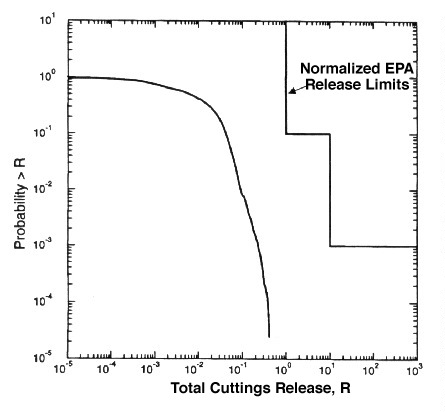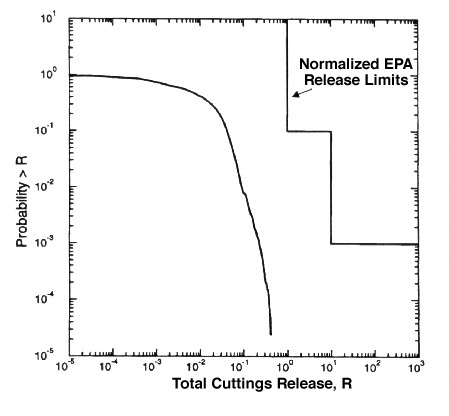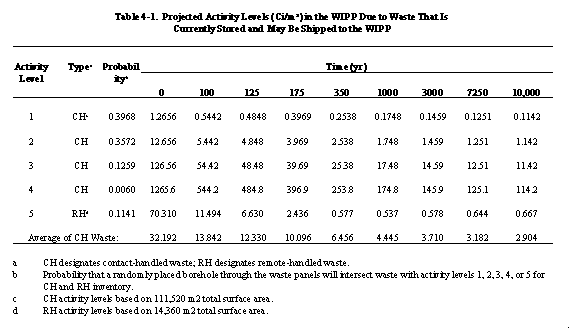4.0 ANALYSIS OF THE IMPACT OF REMOTE-HANDLED WASTE ON PERFORMANCE ASSESSMENT
This section of the RH-TRU Waste Study evaluates the impact of RH-TRU waste on the WIPP Performance Assessment (PA). It does not compare the CH-TRU waste impact to PA with that of RH-TRU waste. This evaluation includes an assessment of the PA activities that could potentially be affected by the inclusion of RH-TRU waste and its characteristics. The inventory considered in this evaluation includes the most current waste data as described in the WTWBIR [DOE, 1995e].
The EPA defined PA in 40 CFR Part 191 as ". . . an analysis that: (1) Identifies the processes and events that might affect the disposal system; (2) examines the effects of these processes and events on the performance of the disposal system; and (3) estimates the cumulative releases of radionuclides, considering the associated uncertainties, caused by all significant processes and events. These estimates shall be incorporated into an overall probability distribution of cumulative release to the extent practicable" [EPA, 1985]. DOE includes compliance with 40 CFR Part 268 in its evaluation of long-term repository performance [DOE, 1995g]. These regulations specify the EPA's environmental radiation protection standards for management and disposal of spent nuclear fuel and high-level and transuranic radioactive wastes, along with its regulations for the disposal of RCRA-classified hazardous waste.
Since the emphasis of this section is to describe the impact of RH-TRU waste on long-term repository performance, the features, events, and processes (FEPs) associated with RH-TRU waste and those that could potentially result in a regulatory violation must first be identified. The FEPs that are significant relative to the evaluation of RH-TRU wastes include gas generation, radionuclide migration by groundwater transport, cuttings releases by human intrusion, and radiolytic heat generation. These FEPs are described in the document entitled Systems Prioritization Method Iteration 2 Baseline Position Paper: Scenario Development for Long-Term Performance Assessments of the WIPP, dated March 17, 1995 [Galson et al., 1995]. The impact of these FEPs on PA relative to RH-TRU waste are discussed below.
With respect to RCRA-regulated constituents, the CH-TRU and RH-TRU waste inventories are anticipated to be very similar, which is evident by the direct correlation of RCRA EPA codes reported in the WTWBIR for CH-TRU and RH-TRU wastes. Therefore, the contribution of RCRA constituents by the RH-TRU inventory to the total TRU inventory is anticipated to be very small due to the limited quantity of RH-TRU wastes to be received at WIPP and is therefore not specifically addressed in PA.
4.1 Gas Generation
Gas generation could occur in the waste-filled regions of the repository and is included as part of the modeling effort associated with the WIPP PA. The primary mechanisms identified as being important in influencing the potential for gas generation are corrosion processes and microbial activity [Brush, 1995]. If sufficient quantities of gases are generated in the repository, elevated pressures exceeding lithostatic (approximately 15 MPa) could result. These elevated pressures could open fractures in the brittle anhydrite layers above and below the waste-disposal panels. Elevated pressures and/or fractures in the repository could also influence fluid flow and subsequent contaminant migration in and around the repository [Galson et al., 1995].
The PA process does not explicitly evaluate the gas potential contribution from RH-TRU waste alone; rather, it evaluates gas potential from the waste form distribution expected to be present in the total quantity of CH-TRU and RH-TRU waste. The comparison of CH-TRU and RH-TRU gas generating waste materials (section 3.2.1) has indicated that the amount of gas generated from RH-TRU corrodible and organic waste forms in the WIPP repository can range from approximately zero to 31 percent of the total corrodible waste inventory and approximately zero to 1 percent of the total organic waste inventory. However, the potential for anoxic corrosion to stop prior to producing significant quantities of gas and the potential for passivation of steel and other iron-base metals from microbial degradation products, along with an alternative design for the RH-TRU shield plug, would significantly reduce the expected range for gas generation from corrosion.
Sensitivity analyses on gas generation parameters have also been performed to provide perspective on compliance with EPA regulations in 40 CFR Part 191 and guidance for additional research. Through this process, the gas generation model parameters associated with the mass of the metals has been identified as having limited or no observed effects in an intrusion scenario [Sandia WIPP Project, 1991 and 1992]. Through WIPP PA modeling efforts, gas generation is coupled with brine inflow and outflow. Thus, the availability of water in the WIPP repository may limit anoxic corrosion and therefore hydrogen generation, regardless of the quantity of CH-TRU and RH-TRU steels and other iron-base alloys and packaging materials included in the WIPP inventory [Brush, 1995]. Calculations for undisturbed scenarios in the WIPP PA process involving gas generation indicated that none of the calculations resulted in 100 percent consumption of the CH-TRU iron-base alloys in 10,000 years [Howarth et al., 1995]. Therefore, any additional quantities of metal such as that represented in the RH-TRU waste inventory would not corrode for this scenario. From the RH-TRU waste inventory identified in the WTWBIR, it can be concluded that the RH-TRU gas generating corrodible metal waste represents the most significant contribution from RH-TRU waste to the total gas inventory. However, the potential for anoxic corrosion to stop prior to producing significant quantities of gas and the potential for passivation of steel and other iron-base metals from microbial degradation products, along with an alternative design for the RH-TRU shield plug, would significantly reduce this impact.
4.2 Radionuclide Migration by Groundwater Transport
Mobility of radionuclides in the repository is expected to be influenced by natural, waste, and repository-induced mechanisms (all of which are described below), as well as by human intrusion.
Microbial decomposition of organics in the waste may result in the transport of dissolved or colloidal radionuclides as complexes. Radionuclides will potentially migrate with groundwater to the accessible environment by advection, diffusion, and dispersion through the repository seals and backfill, as well as through the rock matrix and fractures in the interbeds [Howarth et al., 1995]. Other processes influencing radionuclide mobility include sorption, precipitation, and oxidation-reduction reactions.
The following pathways have been identified in PA [Galson et al., 1995] as potentially leading to an eventual radionuclide release beyond the regulatory boundary under undisturbed repository conditions although no such release would occur until after the end of the 10,000-year period of regulatory concern. Disturbed conditions are considered below in subsection 4.3. These pathways are described below.
- A pressure gradient between the repository disposal rooms and the far field causes brine and any dissolved radionuclides to migrate into the anhydrite layers, which are more permeable than the halite typical of the Salado Formation. Once in the anhydrite layers, brine could then migrate to the base of shaft seals and up the shafts into the Culebra and then migrate out to the accessible environment.
- Brine may also continue to migrate laterally through the anhydrite layers until it reaches the subsurface boundary of the accessible environment in the Salado Formation.
- Brine could migrate directly via a pressure gradient from the waste disposal rooms vertically through the Salado Formation and into the Culebra.
Pathways identified above have been evaluated through the PA process. For the first two pathways, assuming seal properties similar to intact halite, calculations of brine transport have indicated that no brine from the repository will reach the accessible environment in the 10,000 years required to be evaluated by the PA [WIPP PA Department, 1992]. In the third case, it has been calculated that extremely long travel times, on the order of 400,000 years, would be required for brine to reach the Culebra [Lappin et al., 1989]. In the interest of being conservative, the PA did not consider the role that waste forms and waste containers might have in the retardation of contaminants under undisturbed conditions [DOE, 1995a].
Because of the long travel times required for brine to reach a regulated boundary by groundwater transport and because, compared to the CH-TRU inventory, the RH-TRU inventory is a very small contributor to radionuclide releases on these time scales, it can be concluded that radionuclides in RH-TRU waste have little impact on the PA.
4.3 Cuttings Releases by Human Intrusion
Human intrusion is the FEP that PA has identified as having the most significant impact on radionuclide releases during the 10,000-year period of regulatory concern. Radionuclides could be released from the cuttings (direct cuttings plus material entrained by drilling fluid) associated with an intrusion borehole caused by drilling into the repository. However, the CUTTINGS model used to evaluate compliance has demonstrated that such cuttings releases would not exceed EPA's radiation standards [Sandia WIPP Project, 1992]. Figure 4-1 shows the complementary cumulative distribution functions (CCDFs) for radionuclide releases predicted by the PA CUTTINGS model, using an updated inventory from the WTWBIR, both for combined CH-TRU and RH-TRU waste and for CH-TRU inventories alone.
A CCDF is a distribution function of releases (and associated probabilities of release) calculated from a set of input parameters. Because of the uncertainty in the models and the input parameters, PA calculations produce a set of CCDFs, each of which is calculated from a different set of sampled parameters. Each CCDF relates the probability of a set of occurrences or events that can take place to the probability of the set of consequences that can happen if they do occur. Figure 4-1 demonstrates the relationship between the magnitude of a radionuclide release via borehole cuttings to the probability that these releases will exceed EPA release limits. The straight stairstep-like line in this figure represents the summed normalized EPA limits for radionuclide releases. If a CCDF curve were to extend to the right of the normalized standards curve, it could be concluded that a violation of the standards would occur. The EPA has stated that "a disposal system can be considered to be in compliance with 40 CFR Part 191.13 if this single distribution function meets the requirements of 40 CFR Part 191.13a (the stairstep EPA release limits)." Figure 4-1 shows the mean probability of a release for a set of CCDFs.

Mean CCDF for Combined CH-TRU and RH-TRU Waste Inventory

Mean CCDF for CH-TRU Waste Inventory
Examination of the two CCDF figures reveals that there is no observable impact from the RH-TRU contribution to the waste inventory on the probability of a radionuclide release to exceed EPA standards. These CCDFs considered human intrusion to occur over the time period of 100 to 10,000 years. Table 4-1 identifies the projected activity levels in WIPP over the compliance period based on the WTWBIR. The CH-TRU waste was partitioned into four activity levels with a probability associated with each activity level. The RH-TRU waste was evaluated at one activity level. The probability for the RH-TRU activity level (5) is based on the relative area of RH-TRU waste emplacement to the total waste emplacement area. This table includes the probabilities for the assessment of both CH-TRU and RH-TRU human intrusion. When the CH-TRU inventory was evaluated alone, the RH-TRU intrusions were simply not included in the calculations as a release.

There are several observations that can be made from Table 4-1 that explain the results from comparing the CCDFs in Figure 4-1. Table 4-1 shows that the probability of hitting RH-TRU waste if an intrusion occurs is 0.1141 and that after 175 years the release from an intrusion into an RH-TRU waste canister is less than the release from CH-TRU waste activity level 2, 3, or 4. The probability of an intrusion into activity levels 2, 3, and 4 is 0.4891. After 350 years, the activity level of the RH-TRU waste is slightly larger than the activity of CH-TRU activity level 1. The probability of hitting CH-TRU waste activity level 1 if an intrusion occurs is 0.3968 compared to 0.1141 for RH-TRU. To identify an effect of RH-TRU waste on the CCDFs, the intrusion into the lower probability RH-TRU canister must be calculated and the release from this intrusion must be significant in comparison to intrusions calculated for the range of activity levels of CH-TRU. The identical CCDFs indicate that there were no significant consequences from intrusions into RH-TRU canisters compared to the CH-TRU activity levels.
It can be concluded, then, that RH-TRU waste has little or no contribution to radionuclide releases that may be caused by a human intrusion drilling activity, and therefore there is minimal impact on the WIPP PA.
4.4 Radiolytic Heat Generation
Two concerns have been identified relative to radiolytic heat generation in the repository. The first is the potential for fractures to develop around the waste-filled regions or in repository seals and backfill from thermally induced stress. Fracturing of the formation could provide pathways in which contaminated brine could migrate toward the regulatory boundary [Galson et al., 1995]. The second is related to thermal convection that could enhance water-vapor transport in the gas phase. As this gas travels away from the heat-generating waste forms into cooler regions of the waste disposal rooms, the potential exists for greater contact between the waste and liquid water due to condensation of the water vapor [Butcher et al., 1995]. A detrimental effect of these occurrences could be an earlier-than-anticipated release of radionuclides beyond the regulatory boundary because most of the heat developed as a result radiolytic decay of RH-TRU waste will occur early in the post-closure period. If a release occurred within the first 200 years after disposal, radionuclides from RH-TRU waste could potentially contribute to that release.
To determine whether heat generation would have an impact on the performance of the repository, two WIPP-specific studies [Arguello and Torres, 1988; Molecke et al., 1993] regarding heat and thermal effects from RH-TRU waste were examined. The 1988 study utilized a two-dimensional, nonlinear heat conduction finite-element code. The reference case used in model analysis assumed a heat output of 60 W per canister, which resulted in a maximum formation temperature rise of about 3.5 degrees C above an assumed ambient of 27 degrees C over a 6-year period.
The 1993 study [Molecke et al., 1993] included in-situ experiments to ascertain the impacts of heat in the repository. Temperature results were monitored over a 5-year period while evaluating two heat output conditions, of 115 and 300 W. The temperatures observed in the first condition ranged from 3 to 4 degrees C above ambient as measured at the top of the borehole-air interface. In the second condition, the temperatures were on the order of 7 to 9 degrees C above ambient. The ambient formation temperature for these test conditions was about 28 degrees C.
These studies indicate that insufficient heat will be generated from RH-TRU waste to promote formation of fractures or significant quantities of water vapor and therefore will have no significant impact on PA. This conclusion is especially true as the anticipated initial heat output from the RH-TRU waste canisters is about 1.0 W (as estimated from the TRU radionuclide inventory, Appendix B) and is well below the range of 60 to 300 W evaluated in these studies.
4.5 Conclusions
From this evaluation of the impact of RH-TRU waste on PA it can be concluded that the effect on the expected repository performance from the RH-TRU waste component of the TRU waste inventory will be insignificant over the long term. The four FEPs identified as having a potential contribution to repository performance due to the RH-TRU waste inventory have demonstrated minimal effects for two primary reasons. The first reason is the small contribution of RH-TRU waste based on the volume (5 percent) of the total inventory. Gas generation by the waste inventory has been shown in section 3.0 to be dependent on the brine inflow; therefore, the addition of the RH-TRU inventory should not significantly increase the total gas inventory. The second is that the high concentrations of radionuclides unique to the RH-TRU waste decay rapidly over a short period of time relative to the 10,000-year regulatory compliance period. Of chief importance is that RH-TRU waste will begin to exhibit essentially the same radiological characteristics as CH-TRU waste after the first few hundred years of disposal.
Continue to Section 5
Return to Table of Contents
|
Notice To Users: |
Have a question about WIPP? |